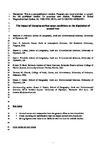The impact of changing surface ocean conditions on the dissolution of aerosol iron
| dc.contributor.author | Fishwick, MP | |
| dc.contributor.author | Sedwick, PN | |
| dc.contributor.author | Lohan, MC | |
| dc.contributor.author | Worsfold, Paul | |
| dc.contributor.author | Buck, KN | |
| dc.contributor.author | Church, TM | |
| dc.contributor.author | Ussher, Simon | |
| dc.date.accessioned | 2016-02-19T14:00:24Z | |
| dc.date.available | 2016-02-19T14:00:24Z | |
| dc.date.issued | 2014-11-15 | |
| dc.identifier.issn | 0886-6236 | |
| dc.identifier.issn | 1944-9224 | |
| dc.identifier.uri | http://hdl.handle.net/10026.1/4348 | |
| dc.description.abstract |
<jats:title>Abstract</jats:title><jats:p>The proportion of aerosol iron (Fe) that dissolves in seawater varies greatly and is dependent on aerosol composition and the physicochemical conditions of seawater, which may change depending on location or be altered by global environmental change. Aerosol and surface seawater samples were collected in the Sargasso Sea and used to investigate the impact of these changing conditions on aerosol Fe dissolution in seawater. Our data show that seawater temperature, pH, and oxygen concentration, within the range of current and projected future values, had no significant effect on the dissolution of aerosol Fe. However, the source and composition of aerosols had the most significant effect on the aerosol Fe solubility, with the most anthropogenically influenced samples having the highest fractional solubility (up to 3.2%). The impact of ocean warming and acidification on aerosol Fe dissolution is therefore unlikely to be as important as changes in land usage and fossil fuel combustion. Our experimental results also reveal important changes in the size distribution of soluble aerosol Fe in solution, depending on the chemical conditions of seawater. Under typical conditions, the majority (77–100%) of Fe released from aerosols into ambient seawater existed in the colloidal (0.02–0.4 µm) size fraction. However, in the presence of a sufficient concentration of strong Fe‐binding organic ligands (10 n<jats:italic>M</jats:italic>) most of the aerosol‐derived colloidal Fe was converted to soluble Fe (<0.02 µm). This finding highlights the potential importance of organic ligands in retaining aerosol Fe in a biologically available form in the surface ocean.</jats:p> | |
| dc.format.extent | 1235-1250 | |
| dc.language | en | |
| dc.language.iso | en | |
| dc.publisher | American Geophysical Union (AGU) | |
| dc.subject | iron | |
| dc.subject | biogeochemistry | |
| dc.subject | marine aerosols | |
| dc.subject | climate change | |
| dc.subject | ligands | |
| dc.subject | colloids | |
| dc.title | The impact of changing surface ocean conditions on the dissolution of aerosol iron | |
| dc.type | journal-article | |
| dc.type | Journal Article | |
| plymouth.author-url | http://gateway.webofknowledge.com/gateway/Gateway.cgi?GWVersion=2&SrcApp=PARTNER_APP&SrcAuth=LinksAMR&KeyUT=WOS:000346594100005&DestLinkType=FullRecord&DestApp=ALL_WOS&UsrCustomerID=11bb513d99f797142bcfeffcc58ea008 | |
| plymouth.issue | 11 | |
| plymouth.volume | 28 | |
| plymouth.publication-status | Published | |
| plymouth.journal | GLOBAL BIOGEOCHEMICAL CYCLES | |
| dc.identifier.doi | 10.1002/2014GB004921 | |
| plymouth.organisational-group | /Plymouth | |
| plymouth.organisational-group | /Plymouth/Faculty of Science and Engineering | |
| plymouth.organisational-group | /Plymouth/Faculty of Science and Engineering/School of Geography, Earth and Environmental Sciences | |
| plymouth.organisational-group | /Plymouth/REF 2021 Researchers by UoA | |
| plymouth.organisational-group | /Plymouth/REF 2021 Researchers by UoA/UoA07 Earth Systems and Environmental Sciences | |
| plymouth.organisational-group | /Plymouth/Research Groups | |
| plymouth.organisational-group | /Plymouth/Research Groups/BEACh | |
| plymouth.organisational-group | /Plymouth/Research Groups/Marine Institute | |
| plymouth.organisational-group | /Plymouth/Users by role | |
| plymouth.organisational-group | /Plymouth/Users by role/Academics | |
| plymouth.organisational-group | /Plymouth/Users by role/Researchers in ResearchFish submission | |
| dcterms.dateAccepted | 2014-10-15 | |
| dc.rights.embargodate | 2015-11-15 | |
| dc.identifier.eissn | 1944-9224 | |
| dc.rights.embargoperiod | 12 months | |
| rioxxterms.versionofrecord | 10.1002/2014GB004921 | |
| rioxxterms.licenseref.uri | http://www.rioxx.net/licenses/under-embargo-all-rights-reserved | |
| rioxxterms.licenseref.startdate | 2014-11-15 | |
| rioxxterms.type | Journal Article/Review |


